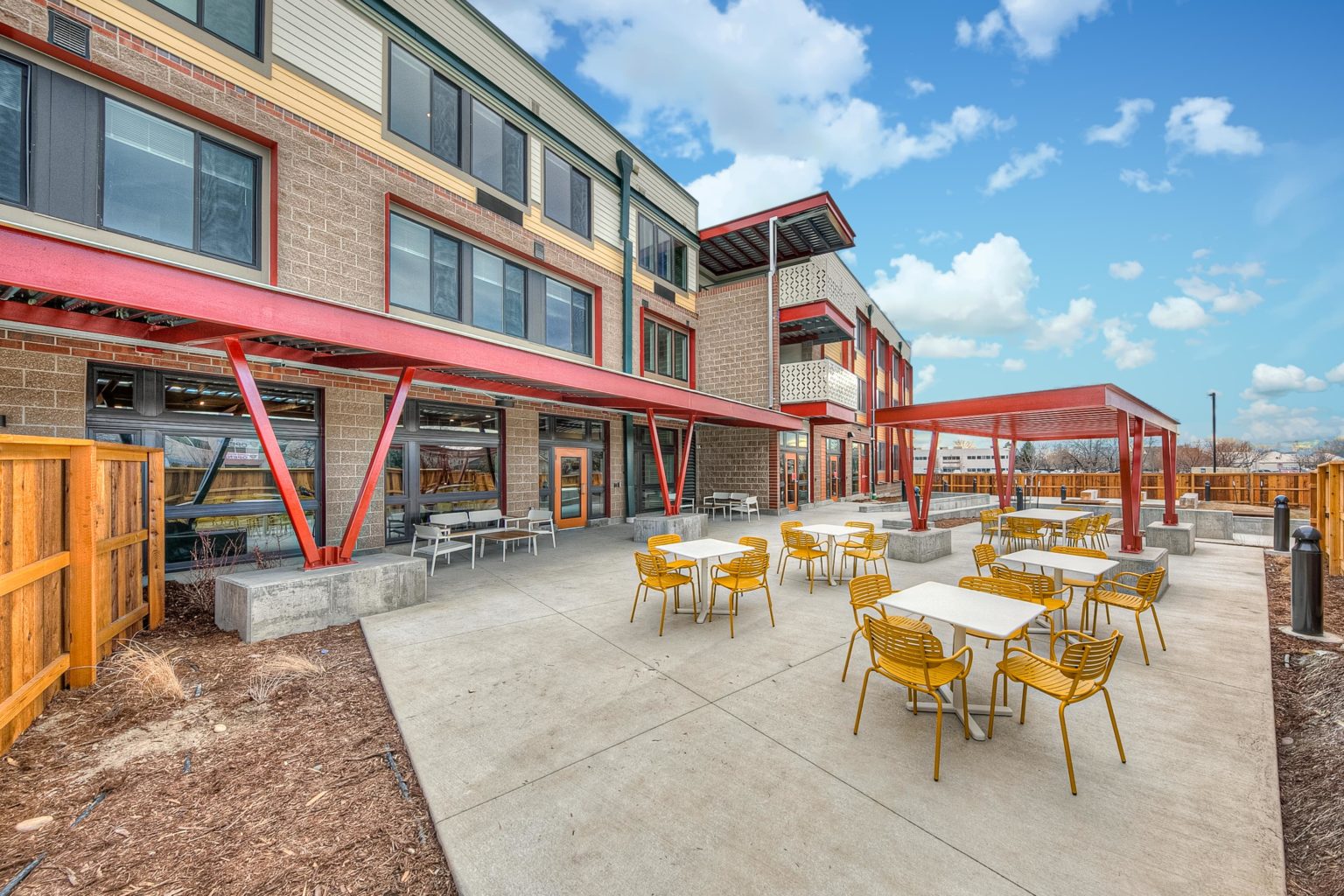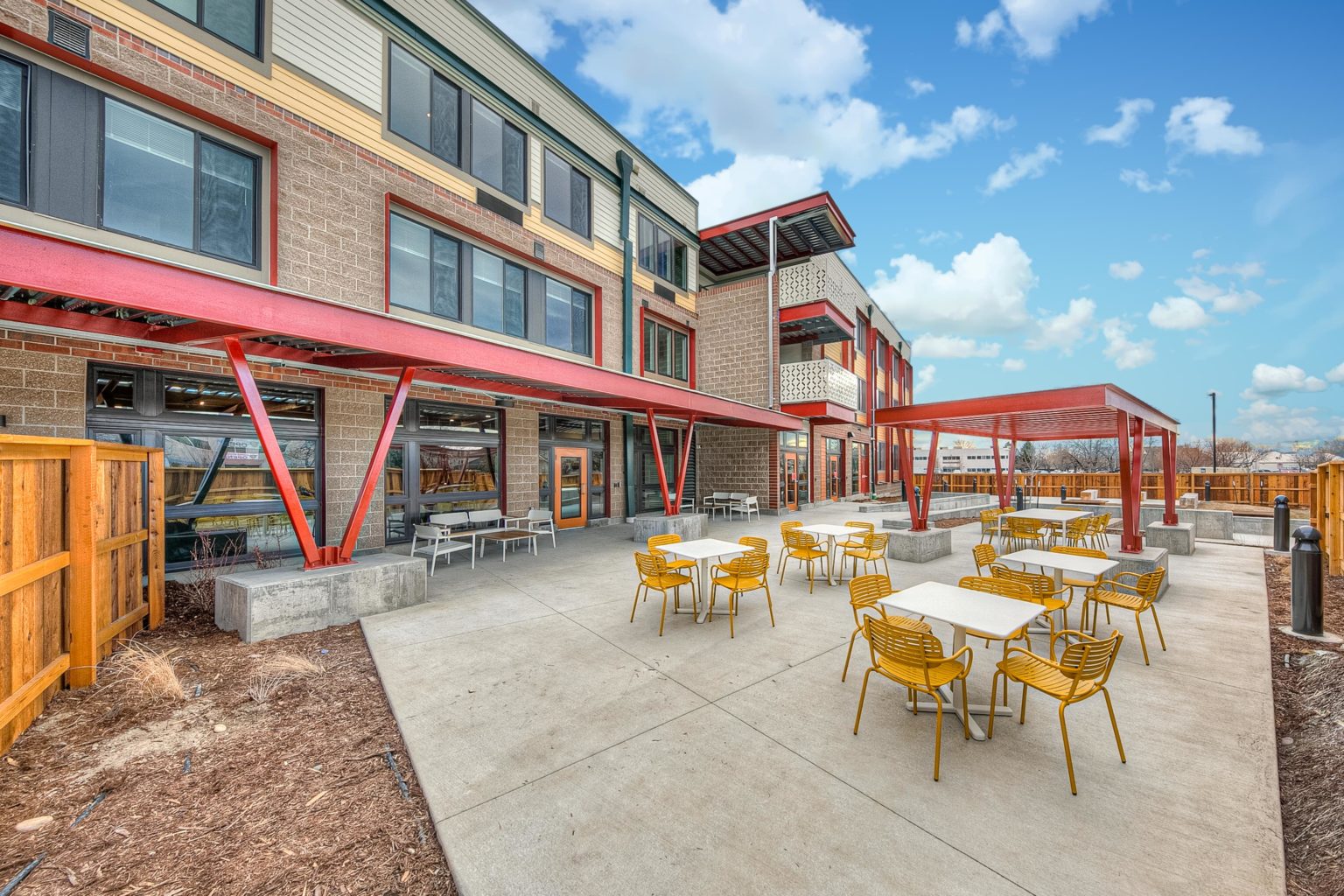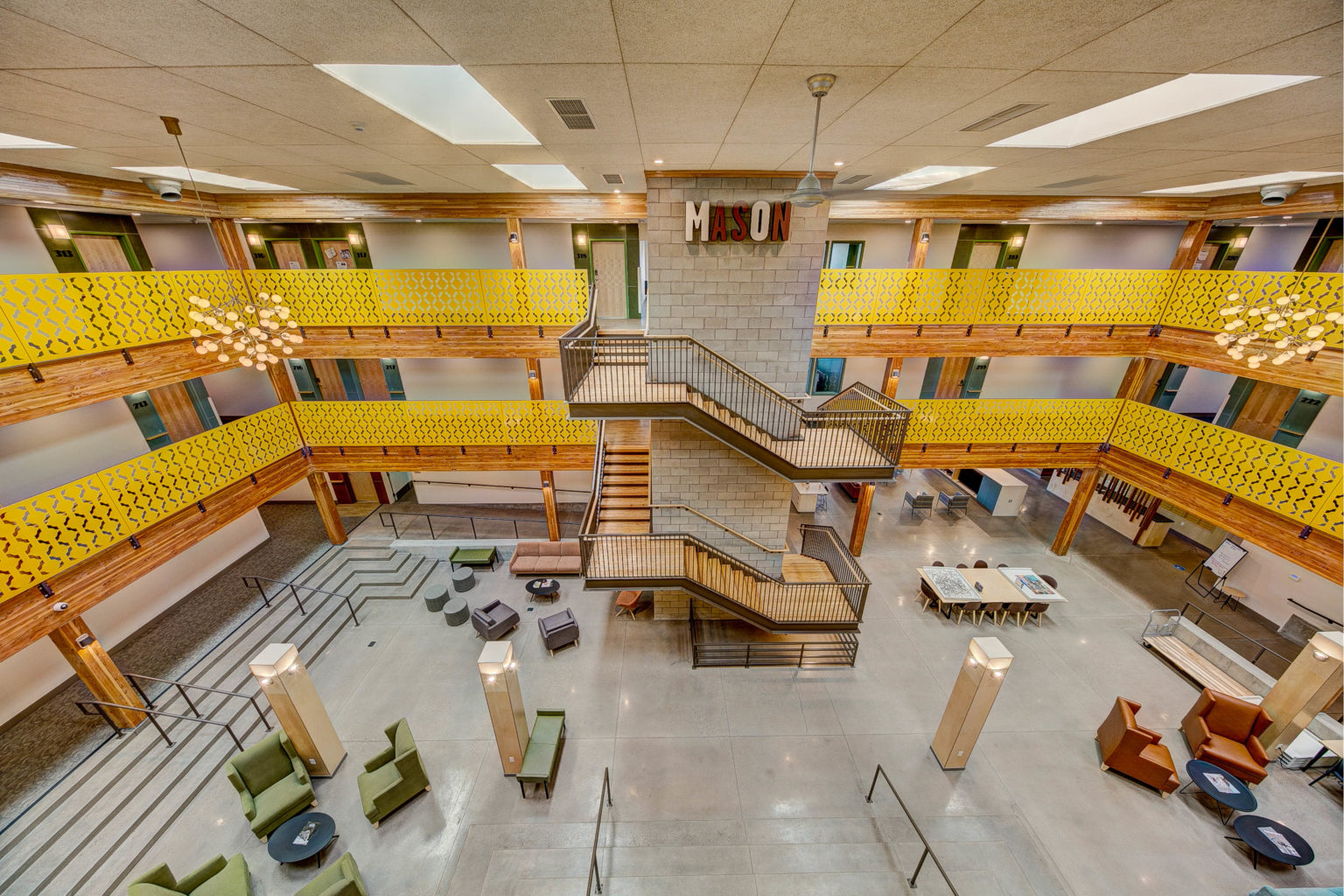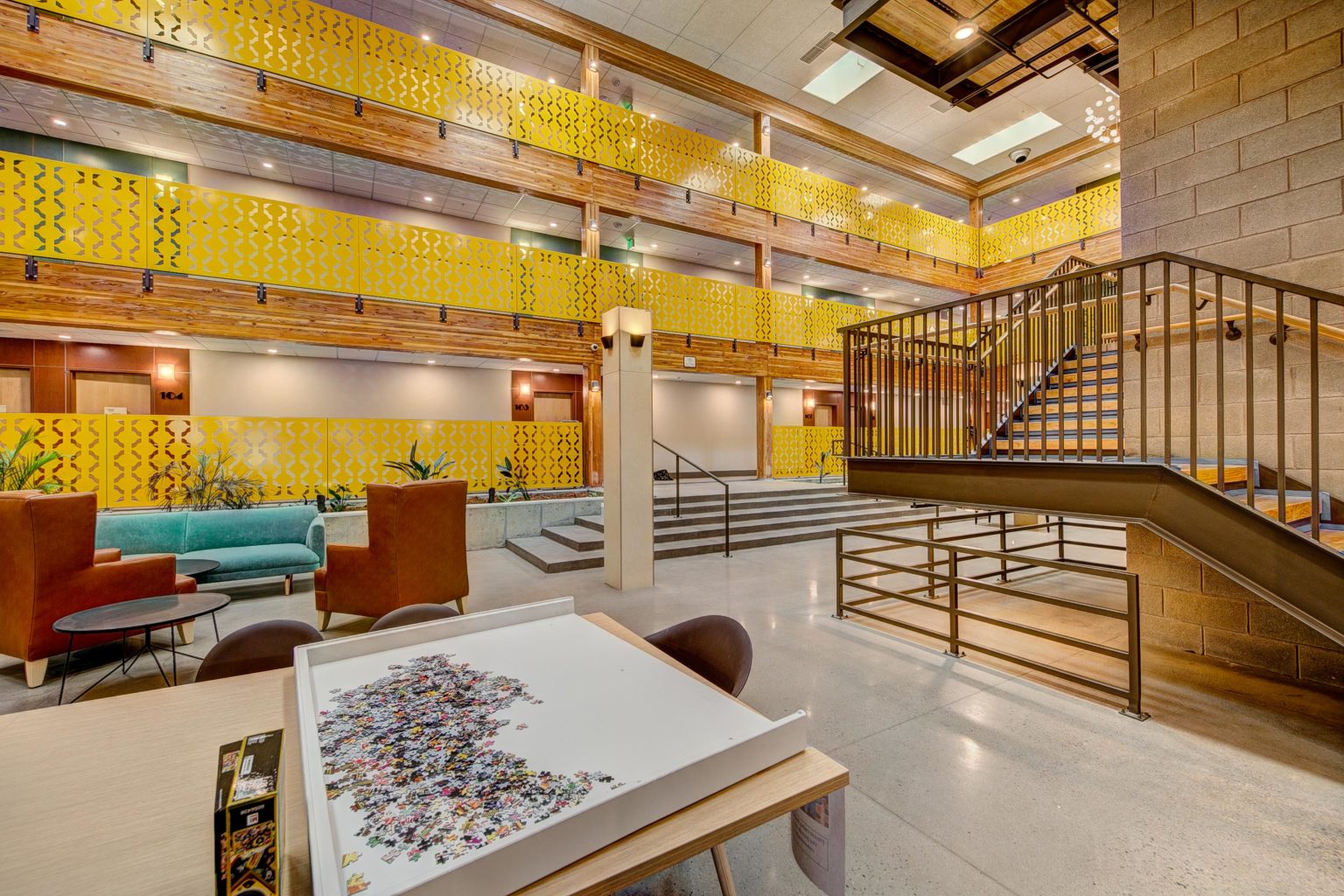Mason Place Apartments
Created on 18-10-2023 | Updated on 11-12-2023
Mason Place Apartments is a 60-unit permanent supportive housing development in Fort Collins, a city in the state of Colorado, USA. The building was initially constructed in 1982 and functioned as a cinema until 1999. The development was converted into permanent supportive housing by Housing Catalyst, a public housing agency and real estate developer. This affordable and supportive housing community project was developed through a collaborative effort of multiple funders (National Equity Fund; Colorado Housing and Finance Authority; Colorado Division of Housing; city of Fort Collins; Column Financial; ANB Bank; Department of Housing and Urban Development; Department of Veterans Affairs), applying the principles of trauma-informed design. It is a three-story apartment building that provides affordable housing and supportive services to people with disabilities, homeless people, and military veterans who earn less than 30% of the median income in the area. The first floor includes apartments, staff offices, and common areas for residents and staff. The remaining apartments are located on the upper two levels.
Architect(s)
Shopworks Architecture
Location
Fort Collins, Colorado
Project (year)
2021
Construction (year)
2021
Housing type
60-unit permanent supportive housing development
Urban context
-
Construction system
-
Status
Built
Description
Mason Place is a permanent supportive housing development in the city of Fort Collins, Colorado, US, developed by Housing Catalyst, that uses trauma-informed design to create a safe and supportive environment for residents. It is a home to individuals who may have been suffered both short and long-term periods of homelessness while ten units are reserved for veterans (Housing Catalyst, 2021; Kimura, 2021). For over five decades, Housing Catalyst has been a cornerstone of the Northern Colorado community, unwavering in its commitment to providing accessible and affordable housing solutions. Through innovative, sustainable, and community-centric approaches, Housing Catalyst has developed and managed over 1,000 affordable homes, becoming the largest property manager in the region (Housing Catalyst, 2021). Housing Catalyst plays a pivotal role in administering housing assistance programs, serving thousands of residents each year. With a steadfast focus on families with children, seniors, individuals with disabilities, and those experiencing homelessness, Housing Catalyst tirelessly strives to make homeownership a reality for all (Housing Catalyst, 2021).
To create Mason Place, Housing Catalyst gave a new purpose to an old movie theatre by designing it with trauma survivors in mind. This resulted in a building with a skylighted atrium, large windows in units and common spaces, live plants, and wooden skirting board to create a calming environment. Case managers (on-site service assistants provided by the Homeward Alliance) worked with residents to develop and implement individualized plans to address their unique needs. This included assistance with finding employment, accessing healthcare, and securing permanent housing. Case managers also provided support and encouragement for residents to develop the skills and helped them to gain confidence (Homeward Alliance, 2021). David Rout, executive director of Homeward Alliance, said:
“When it comes to our community's ongoing effort to make homelessness rare, short-lived and non-recurring, developments like Mason Place are the gold standard. It will immediately provide dozens of our most vulnerable neighbors with a safe place to live and the supportive services they need to stay housed, healthy and happy” (Coloradoan, 2021).
Homeward Alliance, a non-profit organization that provides a continuum of care in Fort Collins, provided two case managers at Mason Place, who worked with individuals and families to develop plans to address their long-term needs, and to help residents with Activities of Daily Living (ADLs), such as using the bus system, proper personal hygiene, and cooking, as well as Instrumental Activities of Daily Living (IADLs), among them, accessing treatment for mental health issues, applying for a job, and obtaining healthcare benefits. In addition to case management, Homeward Alliance also provided a variety of support services, including mental health services, substance abuse treatment, employment services, and other needed care.
Affordability aspects
The affordability of housing has been a long-standing priority for the city of Fort Collins. As highlighted in the city plan (City of Fort Collins, 2023), and also in the housing strategic plan (City of Fort Collins, 2021), housing affordability is a key element of community liveability. The Transit-Oriented Development (TOD) overlay zones, such as the College/Mason corridor to the South Transit Center are used to encourage higher-density development in areas that are well-served by public transit. These zones typically have additional land use code standards, such as higher density requirements, mixed-use requirements, and pedestrian-friendly design standards. One of the provisions of the TOD is the allowance of one additional story of building height if the project qualifies as an affordable housing development and is south of Prospect Road. This allows the developer to build more units in exchange for 10% of the units overall being affordable to households earning 80% of Area Median Income (AMI) or less. This provision is designed to increase the supply of affordable housing in TOD areas, which are typically located near public transit and other amenities. By allowing developers to build more units in exchange for providing affordable housing, TOD areas become more accessible to lower-income residents. In addition to increasing the supply of affordable housing, TOD can also help to achieve other sustainability goals. For example, encouraging people to live in those areas helps to reduce vehicle miles travelled and air pollution. Overall, the TOD provision is a win-win for both developers and communities. It allows developers to build more units in desirable locations, and it helps to provide inclusive and affordable for all residents (City of Fort Collins, 2021).
As the community continues to grow, a significant portion of the population is struggling to afford stable and healthy housing. Nearly 60% of renters and 20% of homeowners are cost-burdened (City of Fort Collins, 2021)., meaning they spend more than 30% of their income on housing. Black, Indigenous, and People of Color (BIPOC) and low-income households are disproportionately affected by this issue, with lower homeownership rates, lower income levels, and higher rates of poverty (City of Fort Collins, 2021). The city facilitates affordable housing to promote mixed-income neighbourhoods and reduce concentrations of poverty. In 2018 Housing Catalyst submitted a funding application to the Colorado Housing and Finance Authority's Low Income Housing Credit programme and the construction started in 2019. Currently, Mason Place provides affordable housing, in form of low-income apartments, and coordinated services to help people stabilize their lives and move forward.
Housing Catalyst works closely together with the National Equity Fund, which is a nonprofit organization that delivers new and innovative financial solutions to expand the creation and preservation of affordable housing. According to the Fund, everyone deserves a safe and affordable place to live. Their vision is that all individuals and families must have access to stable, safe, and affordable homes that provide a foundation for them to reach their full potential (National Equity Fund, 2022). Mason Place houses the disabled and homeless, including military veterans earning up to 30 percent of the area median income, or about $16,150 for a single person.
Alignment with project research areas
Mason Place demonstrates the connection and interrelation of the three research areas of RE-DWELL.
Community participation
Housing Catalyst is committed to developing and nurturing community resilience through participatory planning and inclusive decision-making. They recognize that a vibrant community is one that values and amplifies the voices of its residents, and they have established clear policies and procedures to promote respectful behavior and address any conflicts that may arise. By fostering open communication and collaboration, Housing Catalyst seeks to create a community environment where people feel valued and empowered.
Design, planning and building
TID principles provide a thoughtful way to create spaces that cater to the needs of individuals who have experienced trauma. It also promotes social sustainability by creating communities that are safe, supportive, and empowering for everyone. When people feel safe and well-supported, they are more likely to thrive and contribute to their communities. Mason Place incorporates features to create a pleasant and supportive environment for residents, such as a lobby, smoking balcony, lounges, exercise rooms, counselling spaces, and property management offices to facilitate community building; enclosed spaces where residents may feel vulnerable are equipped with windows and glass doors to provide a sense of safety and openness; clear sightlines and multiple exits are strategically placed to enhance safety and alleviate feelings of claustrophobia; natural light and ventilation create a calming and restorative environment; choice and control over personal space and privacy to ensure comfort and well-being; and opportunities for social connection and community support.
All building staff, including maintenance and security workers, are trained in mental health first aid and trauma-informed care. Housing Catalyst is working with local agencies to provide strong support services for residents. It is also working with the project's investor to create a financial reserve for services and to size the debt so that it can cover higher operating costs.
Policy and financing
Mason Place benefitted from land use code provisions for affordable housing, including low-density mixed-use zone district density bonus and the height bonus in the transit-oriented development overlay zone. Affordable housing projects in the Low-density Mixed-use Neighbourhoods (LMN) are eligible for a density bonus. The maximum density in the LMN zone is typically 9 dwelling units per acre, but affordable housing projects can reach a density of 12 dwelling units per acre. Height bonus means the possibility to build one additional story of building height if 10% of total units are affordable to 80% AMI or less.
Priority processing, that is to say, expedited development review, is a relatively simple policy to implement, and it can have several positive benefits for communities. Affordable housing projects can be eligible for priority processing. In this case, priority processing was also an essential policy to reduce the time it takes for affordable housing projects to move through the development pipeline, which led to lower costs and faster delivery. It also made the project more attractive for developers to build affordable housing, as it reduced the risk and uncertainty associated with these projects, often facing tight budgets and timelines.
* This diagram is for illustrative purposes only based on the author’s interpretation of the above case study
Alignment with SDGs
Mason Place addresses the following Sustainable Development Goals (SDGs):
SDG 1. No poverty: End poverty in all its forms everywhere (Targets: 1.3; 1.4)
It prioritizes the needs of the poor and vulnerable and ensure that they have equal access to essential services. (Highly related)
SDG 3. Good health and well-being: Promote well-being for all at all ages (Target: 3.4)
Prioritizing the health and well-being of tenants is a key objective of the project.
SDG 4. Quality Education: Ensure inclusive and equitable quality education and promote lifelong learning opportunities for all (Target: 4.3)
All tenants, regardless of their background or income, should have the same opportunity to live in affordable housing and attend high-quality schools.
SDG 6. Clean Water and Sanitation (Target: 6.1; 6.2) and 7. Affordable and clean energy: Ensure access to affordable, reliable, sustainable and modern energy for all. (Targets: 7.1; 7.2; 7.3 )
Mason Place was designed in accordance with SDGs 6 and 7, with a focus on water conservation, air sealing, and reducing thermal bridging.
SDG 8. Decent work and economic growth: Promote sustained, inclusive and sustainable economic growth, full and productive employment and decent work for all (Targets: 8.3; 8.5;)
A long-term goal is to help residents return to society and find permanent jobs. (Moderately related)
SDG 10. Reduced inequalities: Reduce inequality within and among countries (Targets: 10.2; 10.3; 10.4)
The goal of the project is to make sure that everyone, regardless of their age, gender, disability, race, ethnicity, origin, religion, or economic or other status, has the same opportunities to participate in society and succeed. (Highly related)
SDG 11. Sustainable cities and communities: Make cities and human settlements inclusive, safe, resilient and sustainable. (Targets: 11.1 ; 11.3 ; 11.5)
Mason Place provides a safe living environment for its tenants, and it can also contribute to the revitalization of the surrounding neighbourhood (hopeful urbanism). (Highly related)
SDG 13. Climate action: Take urgent action to combat climate change and its impacts. (Targets: 13.2 ; 13.3)
Mason Place is a community that is committed to climate-smart planning. This includes raising awareness of climate change and building capacity, both individually and institutionally. (Highly related)
References
References
Kimura D. (2021). Colorado Development Serves as a Model for Trauma-Informed Design. Affordable Housing Finance . https://www.housingfinance.com/developments/colorado-development-serves-as-a-model-for-trauma-informed-design_o
City of Fort Collins (2021). Housing strategic plan. https://www.fcgov.com/housing/files/housing-strategic-plan-2nd-reading-adoption-draft.pdf?1614025567
City of Fort Collins (2023). City Plan. https://www.fcgov.com/cityplan/
Coloradoan (2021). https://eu.coloradoan.com/story/news/2021/02/05/fort-collins-mason-place-gives-formerly-homeless-space-call-home/4372459001/
Housing Catalyst (2021). Housing is the catalyst for building strong communities. https://housingcatalyst.com/
Homeward Alliance (2021). Mason Place. https://www.homewardalliance.org/hwa/mason-place/
National Equity Fund (2022). Developments. https://www.nationalequityfund.org/impact/developments/
Related vocabulary
Housing Affordability
Social Housing
Social Sustainability
Area: Design, planning and building
Created on 17-10-2023
Read more ->Area: Policy and financing
Created on 17-06-2023
Read more ->Area: Community participation
Created on 03-06-2022
Read more ->Related publications
Martin, A. (2023, December). Housing and Healing: The role of trauma informed design in the supportive housing sector. In Transformative Change in the Contested Fields of Care and Housing in Europe, Linz, Austria.
Posted on 27-07-2024
Conference
Read more ->Blogposts

Clashing Vulnerabilities
Posted on 13-02-2023
Secondments
Read more ->





